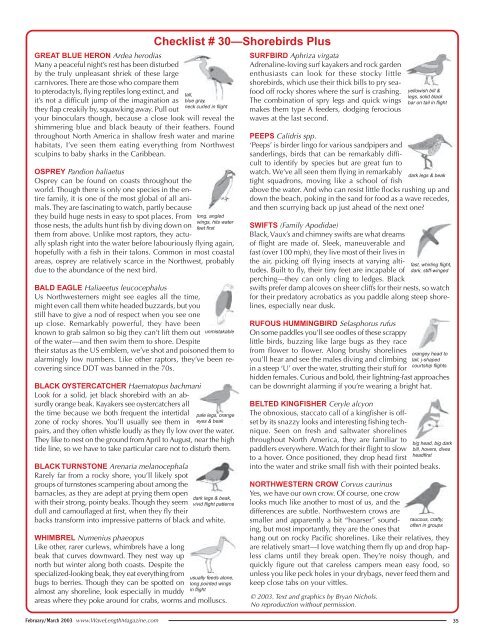download - WaveLength Paddling Magazine
download - WaveLength Paddling Magazine
download - WaveLength Paddling Magazine
Create successful ePaper yourself
Turn your PDF publications into a flip-book with our unique Google optimized e-Paper software.
GREAT BLUE HERON Ardea herodias<br />
Many a peaceful night’s rest has been disturbed<br />
by the truly unpleasant shriek of these large<br />
carnivores. There are those who compare them<br />
to pterodactyls, flying reptiles long extinct, and<br />
it’s not a difficult jump of the imagination as<br />
they flap creakily by, squawking away. Pull out<br />
your binoculars though, because a close look will reveal the<br />
shimmering blue and black beauty of their feathers. Found<br />
throughout North America in shallow fresh water and marine<br />
habitats, I’ve seen them eating everything from Northwest<br />
sculpins to baby sharks in the Caribbean.<br />
OSPREY Pandion haliaetus<br />
Osprey can be found on coasts throughout the<br />
world. Though there is only one species in the entire<br />
family, it is one of the most global of all animals.<br />
They are fascinating to watch, partly because<br />
they build huge nests in easy to spot places. From<br />
those nests, the adults hunt fish by diving down on<br />
them from above. Unlike most raptors, they actually<br />
splash right into the water before labouriously flying again,<br />
hopefully with a fish in their talons. Common in most coastal<br />
areas, osprey are relatively scarce in the Northwest, probably<br />
due to the abundance of the next bird.<br />
BALD EAGLE Haliaeetus leucocephalus<br />
Us Northwesterners might see eagles all the time,<br />
might even call them white headed buzzards, but you<br />
still have to give a nod of respect when you see one<br />
up close. Remarkably powerful, they have been<br />
known to grab salmon so big they can’t lift them out unmistakable<br />
of the water—and then swim them to shore. Despite<br />
their status as the US emblem, we’ve shot and poisoned them to<br />
alarmingly low numbers. Like other raptors, they’ve been recovering<br />
since DDT was banned in the 70s.<br />
BLACK OYSTERCATCHER Haematopus bachmani<br />
Look for a solid, jet black shorebird with an absurdly<br />
orange beak. Kayakers see oystercatchers all<br />
the time because we both frequent the intertidal<br />
zone of rocky shores. You’ll usually see them in<br />
pairs, and they often whistle loudly as they fly low over the water.<br />
They like to nest on the ground from April to August, near the high<br />
tide line, so we have to take particular care not to disturb them.<br />
BLACK TURNSTONE Arenaria melanocephala<br />
Rarely far from a rocky shore, you’ll likely spot<br />
groups of turnstones scampering about among the<br />
barnacles, as they are adept at prying them open<br />
with their strong, pointy beaks. Though they seem<br />
dull and camouflaged at first, when they fly their<br />
backs transform into impressive patterns of black and white.<br />
WHIMBREL Numenius phaeopus<br />
Like other, rarer curlews, whimbrels have a long<br />
beak that curves downward. They nest way up<br />
north but winter along both coasts. Despite the<br />
specialized-looking beak, they eat everything from<br />
bugs to berries. Though they can be spotted on<br />
almost any shoreline, look especially in muddy<br />
areas where they poke around for crabs, worms and molluscs.<br />
Checklist # 30—Shorebirds Plus<br />
tall,<br />
blue gray,<br />
neck curled in flight<br />
long, angled<br />
wings, hits water<br />
feet first<br />
pale legs, orange<br />
eyes & beak<br />
dark legs & beak,<br />
vivid flight patterns<br />
usually feeds alone,<br />
long pointed wings<br />
in flight<br />
SURFBIRD Aphriza virgata<br />
Adrenaline-loving surf kayakers and rock garden<br />
enthusiasts can look for these stocky little<br />
shorebirds, which use their thick bills to pry seafood<br />
off rocky shores where the surf is crashing.<br />
The combination of spry legs and quick wings<br />
makes them type A feeders, dodging ferocious<br />
waves at the last second.<br />
PEEPS Calidris spp.<br />
‘Peeps’ is birder lingo for various sandpipers and<br />
sanderlings, birds that can be remarkably difficult<br />
to identify by species but are great fun to<br />
watch. We’ve all seen them flying in remarkably<br />
dark legs & beak<br />
tight squadrons, moving like a school of fish<br />
above the water. And who can resist little flocks rushing up and<br />
down the beach, poking in the sand for food as a wave recedes,<br />
and then scurrying back up just ahead of the next one?<br />
SWIFTS (Family Apodidae)<br />
Black, Vaux’s and chimney swifts are what dreams<br />
of flight are made of. Sleek, maneuverable and<br />
fast (over 100 mph), they live most of their lives in<br />
the air, picking off flying insects at varying altitudes.<br />
Built to fly, their tiny feet are incapable of<br />
perching—they can only cling to ledges. Black<br />
swifts prefer damp alcoves on sheer cliffs for their nests, so watch<br />
for their predatory acrobatics as you paddle along steep shorelines,<br />
especially near dusk.<br />
RUFOUS HUMMINGBIRD Selasphorus rufus<br />
On some paddles you’ll see oodles of these scrappy<br />
little birds, buzzing like large bugs as they race<br />
from flower to flower. Along brushy shorelines<br />
you’ll hear and see the males diving and climbing<br />
in a steep ‘U’ over the water, strutting their stuff for<br />
hidden females. Curious and bold, their lightning-fast approaches<br />
can be downright alarming if you’re wearing a bright hat.<br />
BELTED KINGFISHER Ceryle alcyon<br />
The obnoxious, staccato call of a kingfisher is offset<br />
by its snazzy looks and interesting fishing technique.<br />
Seen on fresh and saltwater shorelines<br />
throughout North America, they are familiar to<br />
paddlers everywhere. Watch for their flight to slow<br />
to a hover. Once positioned, they drop head first<br />
into the water and strike small fish with their pointed beaks.<br />
NORTHWESTERN CROW Corvus caurinus<br />
Yes, we have our own crow. Of course, one crow<br />
looks much like another to most of us, and the<br />
differences are subtle. Northwestern crows are<br />
smaller and apparently a bit “hoarser” sounding,<br />
but most importantly, they are the ones that<br />
hang out on rocky Pacific shorelines. Like their relatives, they<br />
are relatively smart—I love watching them fly up and drop hapless<br />
clams until they break open. They’re noisy though, and<br />
quickly figure out that careless campers mean easy food, so<br />
unless you like peck holes in your drybags, never feed them and<br />
keep close tabs on your vittles.<br />
© 2003. Text and graphics by Bryan Nichols.<br />
No reproduction without permission.<br />
yellowish bill &<br />
legs, solid black<br />
bar on tail in flight<br />
fast, whirling flight,<br />
dark, stiff-winged<br />
orangey head to<br />
tail, j-shaped<br />
courtship flights<br />
big head, big dark<br />
bill, hovers, dives<br />
headfirst<br />
raucous, crafty,<br />
often in groups<br />
February/March 2003 www.<strong>WaveLength</strong><strong>Magazine</strong>.com<br />
35

















